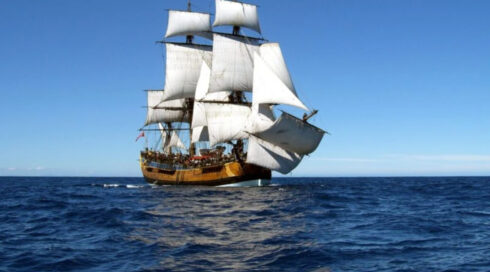Written by Dr. Binoy Kampmark
They found it. Or so we can surmise from the confident words of the Australian National Maritime Museum. The Endeavour is a ship that will be considered alongside other vessels as monumental in its achievement and cursed in its contributions. Britain’s brilliant James Cook was its competent pilot, though it eventually ended up at the bottom of the sea after British forces scuttled it during the American War of Independence in 1778.
According to the ANMM, a wreck in Newport Harbour, off Rhode Island, could be confirmed as the Endeavour.
“I am satisfied,” stated the organisation’s director and CEO Kevin Sumption, “that this is the final resting place of one of the most important and contentious vessels in Australia’s maritime history.”
Not wishing to stop at the significance of the discovery just for Australians, Sumption also called this an “important historical moment” for Aotearoa New Zealand, the United Kingdom and the United States.
Out of courtesy a copy of the report outlining the findings 10 days prior to the announcement was also sent to their partner organisation, the Rhode Island Marine Archaeology Project. The ANMM cited various bits of evidence seeking to make their case. The length of the extant hull was almost identical to that of the Endeavour. The vessel was the largest of the five scuttled transports in an area known as R 2394. The keel’s construction along the bottom of the wreck, the vessel’s fore and main mask, and the joinery used in the bow at the front also seemed to match the original plans.
Those at RIMAP had other ideas about the announcement, showing that fields such as archaeology can be fraught with snide disagreement. RIMAP, an organisation proud to the point of parody, delights in the fact that Rhode Island “has more shipwrecks per square mile than any other state.” With some gravity, it notes how many “sites of archaeological significance are in danger of destruction due to erosion, commercial activity or exploitation.”
The Endeavour maintains a certain pride of place on the organisation’s website. A reading of the detail suggests an almost creepy sense of cloying ownership, with the claim of “sharing the Ocean State’s marine heritage.” RIMAP notes that the ship was initially called the Earl of Pembroke, was built in Whitby, and was piloted by a certain Lt. James Cook of the Royal Navy who “was appointed to command the Endeavour on the scientific voyage to observe the Transit of Venus at Tahiti.”
With such proprietary interest in the vessel, the cattiness of the statement in response to the ANMM finding came as little surprise. The fist fight and bar room brawls were never going to be far off. With ego at high mast, Kathy Abbass of RIMAP claimed that it “is now and always has been the lead organization for the study in Newport harbor.” No upstarts, no interlopers, no challengers. What the ANMM announcement constituted was “a breach of contract between RIMAP and the ANMM for the conduct of this research and how its results are to be shared with the public.”
The organisation accepted that what the findings of the “shipwreck site under study” was “consistent with what might be expected of the Endeavour, but there has been no indisputable data found to prove the site is that iconic vessel, and there are many unanswered questions that could overturn such an identification.”
With a good deal of snark, the project members insisted on its monopoly on knowledge, petulantly asserting that they would finalise the work and tell us all about it. “When the study is done, RIMAP will post the legitimate report on its website”.
Dismissively, Abbass claimed that the Australian side of the bargain could not be taken seriously. Making the ANMM sound like blubbering amateurs and dewy patriots, RIMAP recognised “the connection between Australian citizens of British descent and the Endeavour” but the body’s “conclusions will be driven by proper scientific process and not Australian emotions or politics.”
Kieran Hosty from the ANMM was somewhat bemused by the indignation. “I can’t answer the question of breach of contract, as far as I’m aware the contract with the Rhode Island project expired in November last year.” These gatekeepers are clearly not of one mind.
Though there is nothing – at least on the surface – piratical in this endeavour (RIMAP probably thinks it’s worse than that), interest in the Endeavour can only have increased with such series as Alejandro Amenábar’s La Fortuna, featuring the opportunistic exploits of Frank Wild, ever hungry for the next aquatically buried wreck. Wild’s tactics are, for the most part, dubious in legality. But despite the plotline, the protagonist remains the treasure as everyone else bickers over legal briefs and finer points of maritime law.
In such cases, it’s the journey to the discovery that counts. One gets the sense that RIMAP would hope the Endeavour is never found, confined forever to aquatic slumber and speculation. Expect some scandal on this in due course, perhaps a calculated desecration or targeted demolition. But the gloves are clearly off.
Dr. Binoy Kampmark was a Commonwealth Scholar at Selwyn College, Cambridge. He currently lectures at RMIT University. Email: bkampmark@gmail.com




